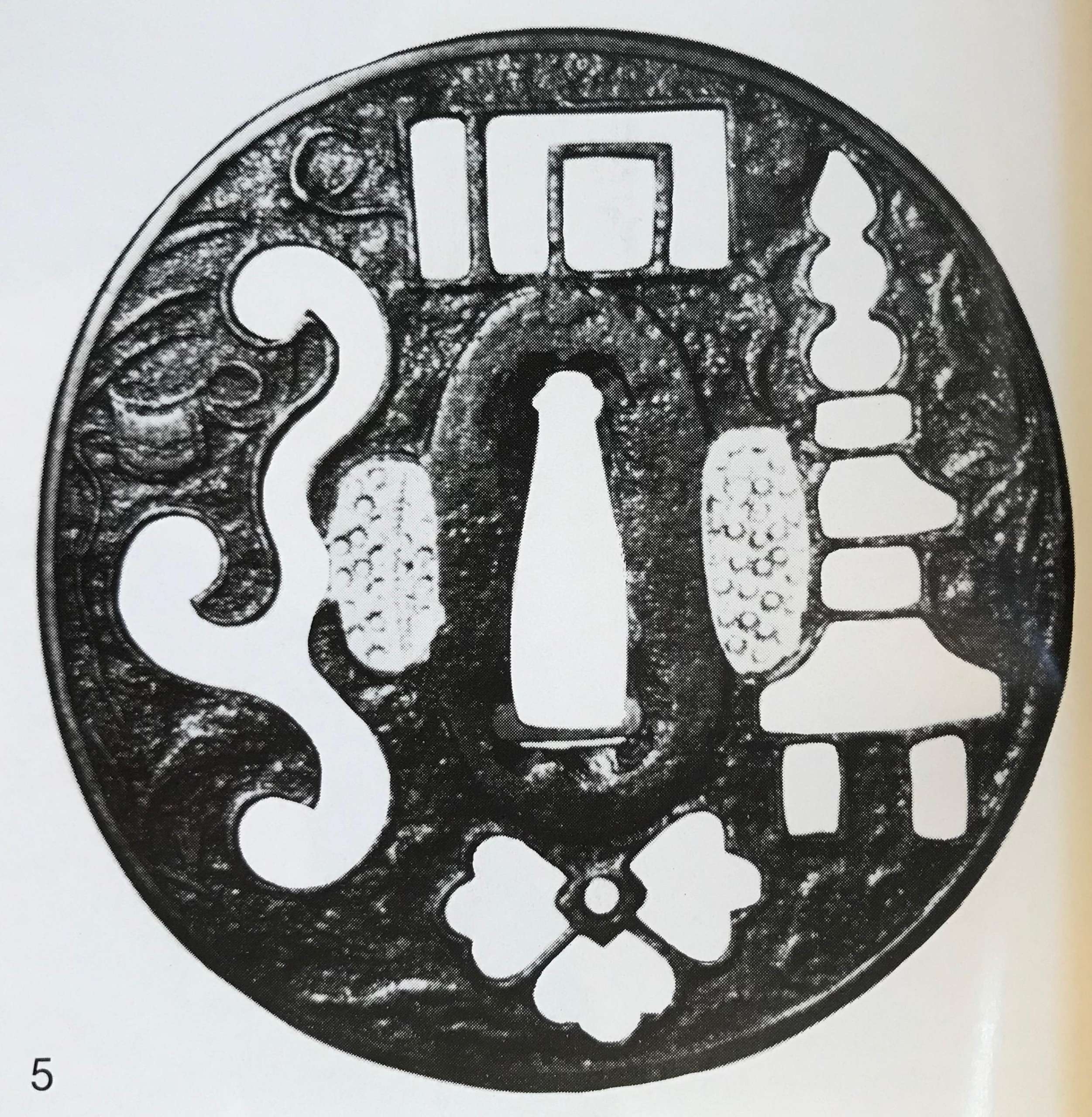
100 selected tsuba from European collections. Catalogue by Robert Haynes and Robert Burawoy, 1984, page 16, №5.
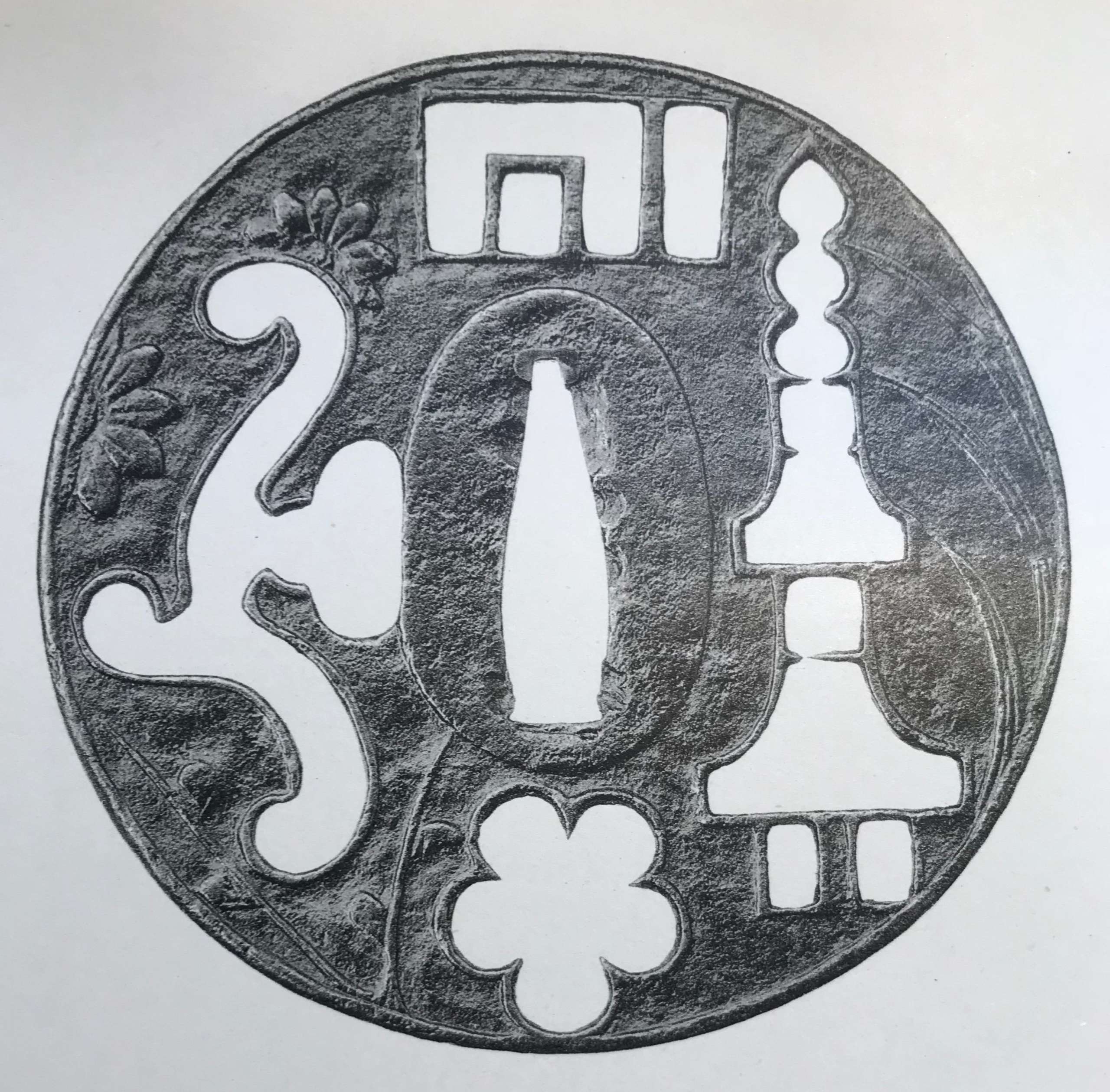
Japanese Sword Fittings. Collection of G.H. Naunton, Esq., by Henri L. Joly, - 1912; №9.
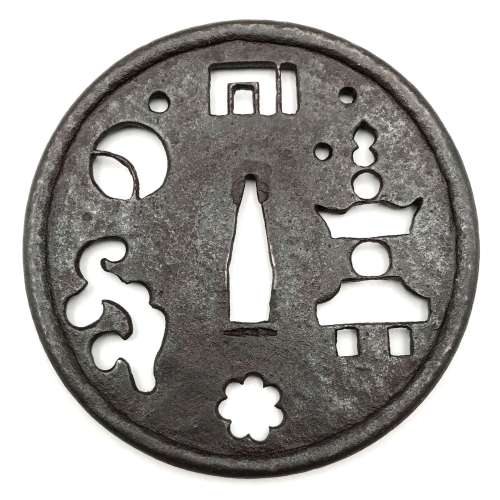

100 selected tsuba from European collections. Catalogue by Robert Haynes and Robert Burawoy, 1984, page 16, №5.

Japanese Sword Fittings. Collection of G.H. Naunton, Esq., by Henri L. Joly, - 1912; №9.
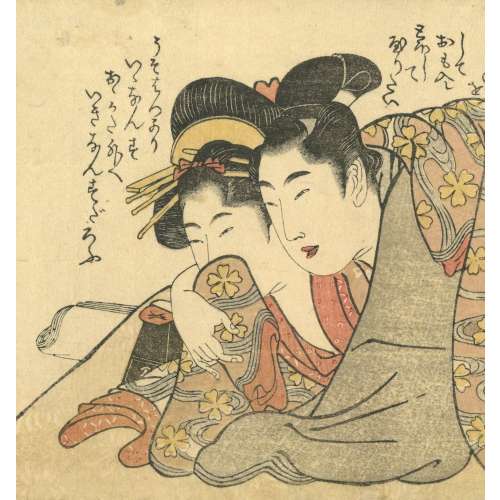
 As Japanese Erotic Fantasies put it: "a couple engaged in love-making, their stare fixed outside the picture plane". This is the only image of series that has a reference in available western literature, and the only one found in museum collections: Rijksmuseum Amsterdam (RP-P-1999-2001-16); reference: Fukuda (ed.) (1990), pls. 11-2.
As Japanese Erotic Fantasies put it: "a couple engaged in love-making, their stare fixed outside the picture plane". This is the only image of series that has a reference in available western literature, and the only one found in museum collections: Rijksmuseum Amsterdam (RP-P-1999-2001-16); reference: Fukuda (ed.) (1990), pls. 11-2.
 The scene of this print looks quite similar to that of the Kiyonaga's Sode no maki:
The scene of this print looks quite similar to that of the Kiyonaga's Sode no maki:
 The woman is "a young lady-in-waiting of Shogun's Court or Daimyō's Mansion, enjoying a rare outing from her tedious chores" [Richard Lane]. She is fully dressed in her outer cloak (shikake), white paper hat (agebōshi or tsunokakushi), and toed socks (tabi). A book or maybe, onkotogami (roll of tissues known as 'paper for honourable act' ) is still in the folds of her kimono. She is holding an open fan, either to cover her and her lover's faces from an unsolicited witness or to bring some fresh air to their joined lips. The pair just started their sexual intercourse.
The woman is "a young lady-in-waiting of Shogun's Court or Daimyō's Mansion, enjoying a rare outing from her tedious chores" [Richard Lane]. She is fully dressed in her outer cloak (shikake), white paper hat (agebōshi or tsunokakushi), and toed socks (tabi). A book or maybe, onkotogami (roll of tissues known as 'paper for honourable act' ) is still in the folds of her kimono. She is holding an open fan, either to cover her and her lover's faces from an unsolicited witness or to bring some fresh air to their joined lips. The pair just started their sexual intercourse.
 A scene from medieval times. A courtier in eboshi cap having sex with an aristocratic young woman with a long straight hairstyle (suihatsu).
A scene from medieval times. A courtier in eboshi cap having sex with an aristocratic young woman with a long straight hairstyle (suihatsu).
 Completely naked couple in the moment of ejaculation. Lavish garments with paulownia leaves on a yellow background counterbalance the white bodies on red bedding. The form of a woman's cheeks is telling, but I don't know about what. Maybe her advanced age?
Completely naked couple in the moment of ejaculation. Lavish garments with paulownia leaves on a yellow background counterbalance the white bodies on red bedding. The form of a woman's cheeks is telling, but I don't know about what. Maybe her advanced age?
 The pose of the couple and the overall composition are similar to that of the previous sheet. Though the lovers are dressed, and the woman's hairdo is well kept. The male looks older and the woman - younger.
The pose of the couple and the overall composition are similar to that of the previous sheet. Though the lovers are dressed, and the woman's hairdo is well kept. The male looks older and the woman - younger.
 A man takes a young maid from behind. She clenches the sleeve of her kimono in her teeth; it's either the moment of penetration (beginning of intercourse) or of her orgasm (the end of it).
A man takes a young maid from behind. She clenches the sleeve of her kimono in her teeth; it's either the moment of penetration (beginning of intercourse) or of her orgasm (the end of it).
 This seems to be a forced intercourse between a lackey with extensive bodily hair and a young maid from the same household.
This seems to be a forced intercourse between a lackey with extensive bodily hair and a young maid from the same household.
 This design is very much like the other one presented below, which is described at Japanese Erotic Fantasies on page 136 (pl. 43b) as follows: "The viewer peers through a mosquito net to see a child fast asleep, while his mother or wet-nurse moves towards her partner. On our print there is no child; instead of a sleeping baby, there is a roll of onkotogami. Fewer objects make the overall image concise, almost laconic in comparison with the Ehon hana fubuki (1802) design:
This design is very much like the other one presented below, which is described at Japanese Erotic Fantasies on page 136 (pl. 43b) as follows: "The viewer peers through a mosquito net to see a child fast asleep, while his mother or wet-nurse moves towards her partner. On our print there is no child; instead of a sleeping baby, there is a roll of onkotogami. Fewer objects make the overall image concise, almost laconic in comparison with the Ehon hana fubuki (1802) design:

 A young couple in a moment of true love. He is listening to the beating of her heart.
A young couple in a moment of true love. He is listening to the beating of her heart.
 This is a moment of true love between an old monk and a young samurai. The latter even did not take of his socks (tabi).
This is a moment of true love between an old monk and a young samurai. The latter even did not take of his socks (tabi).
 From Japanese Erotic Fantasies: "Boats played a crucial role in the workings of Yoshiwara, as they were the primary means of transport to the district. During the hot summer months, trips on pleasure boats were also a favourite pastime. Sex aboard a boat is a recurrent theme in shunga".
The last print that I am currently lacking and hunting for:
From Japanese Erotic Fantasies: "Boats played a crucial role in the workings of Yoshiwara, as they were the primary means of transport to the district. During the hot summer months, trips on pleasure boats were also a favourite pastime. Sex aboard a boat is a recurrent theme in shunga".
The last print that I am currently lacking and hunting for:
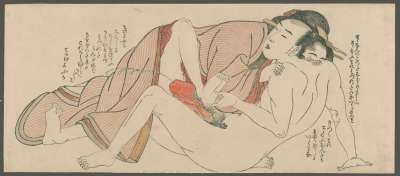 I know where it is, but I cannot reach it... yet.
I know where it is, but I cannot reach it... yet. 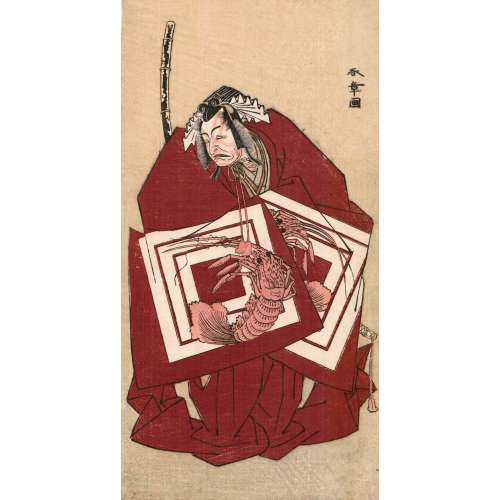
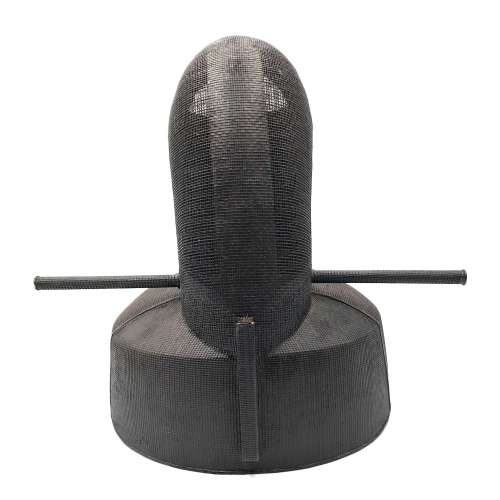
Size: Height:20cm; Width: 21cm; Depth: 20cm.
Probably Taishō period (1912-1926), or later. Certain information is provided at http://www.sengokudaimyo.com/garb/garb.html In a wooden box without inscriptions.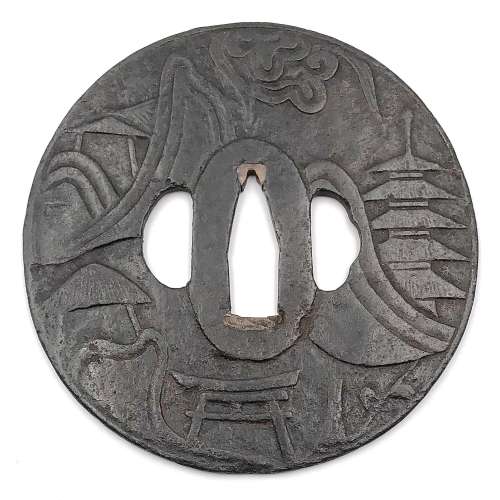
Thin iron plate of round form and black color carved in sukidashi-bori with design of rocks, waves, clouds, temple gates (torii), mountain pavilion and 5-storey pagoda on both sides, alluding to Todai-ji temple in Nara. Hitsu-ana pierced later. Very narrow very slightly raised rim. Copper sekigane.
Late Muromachi period, 16th century. Dimensions: 88.7 x 88.0 x 2.4 mm (seppa-dai), 1.8 mm (base plate).Reference: “Art of the Samurai” on page 232, №140: ”Kamakura tsuba with Sangatsu-do tower and bridge. Muromachi period, 16th century. 83 mm x 80 mm. Unsigned. Tokyo National Museum. The mountain pavilion and bridge carved in sunken relief on the iron tsuba – both part of Tōdai-ji, a temple in Nara – are detailed in fine kebori (line) engraving. As a result of the chiseling used to create the relief, the ground of the piece is relatively thin".
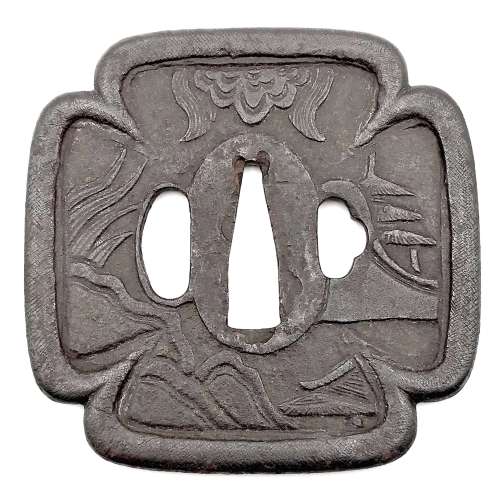
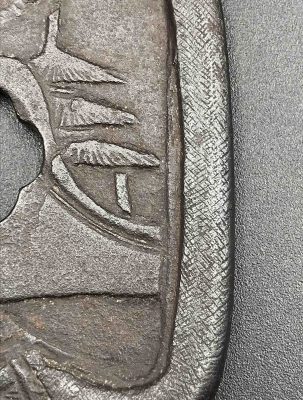
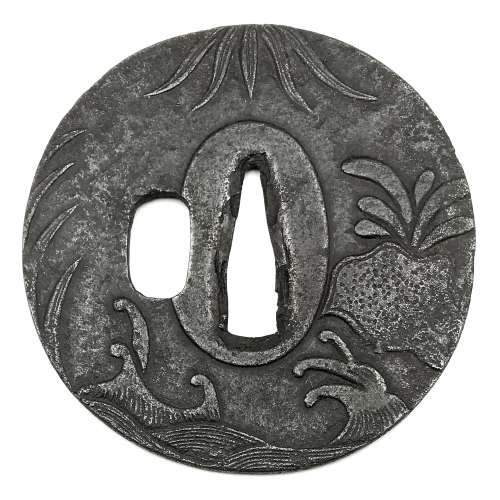

Butterfield & Butterfield, 1979. Sale # 3063, lot № 66.
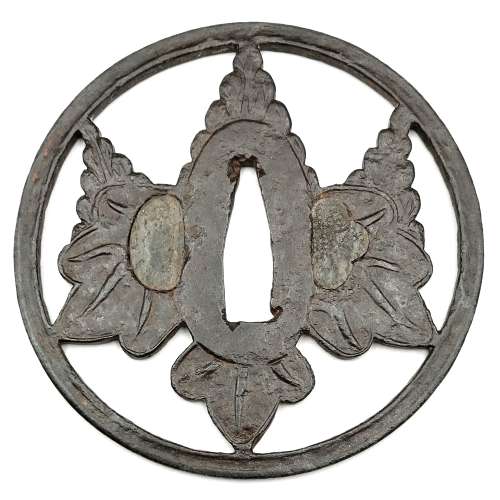
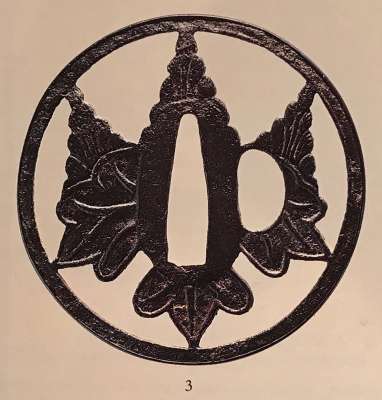
Compton's Collection, Part I, p. 11, №3.
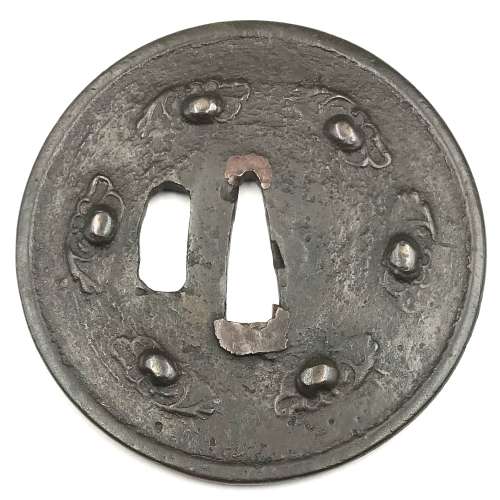
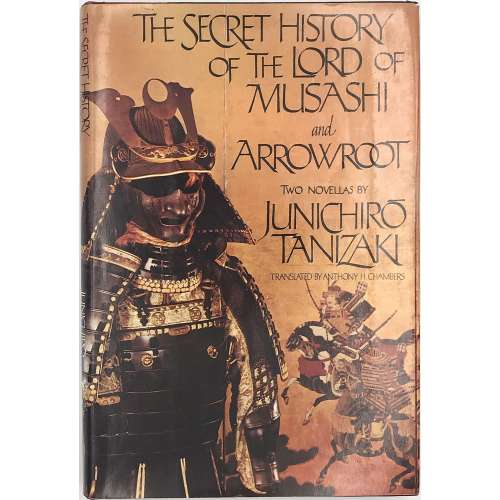
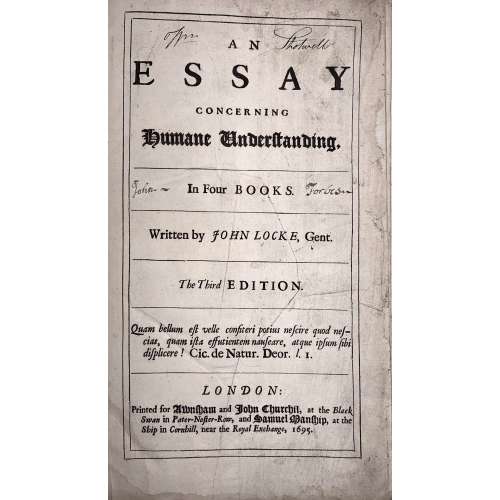
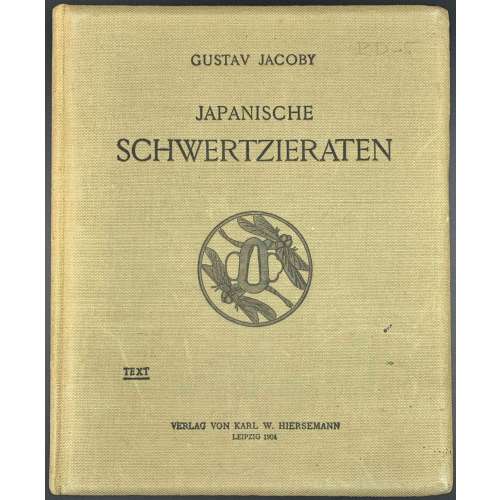
Book size: 25.5 x 21 cm. Hardbound: original olive cloth, lettering and elements on FC and lettering on Sp.
Ex Libris Dr. H. Smidt, with the motto: "Sapienti sat" and a naked bold man at the seashore, holding a fruit behind his back.
Full title: Japanische Schwertzieraten. Beschreibung einer kunstgeschichtlich geordneten Sammlung, mit Charakteristiken der Künstler und Schulen von Gustav Jacoby. Hierzu siebenunddreissig Tafeln in Heliogravüre. [The second volume, which conteined 'heliogravures' is missing and had not be found elsewhere].
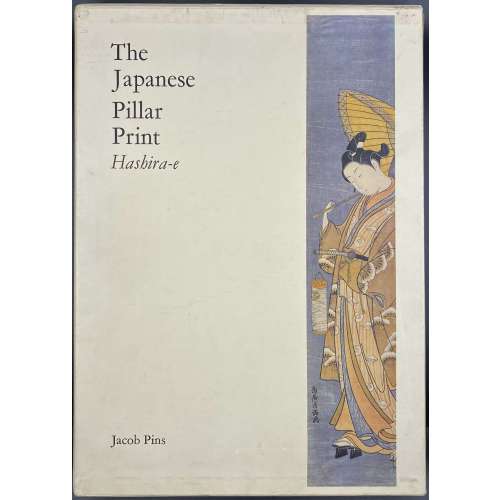
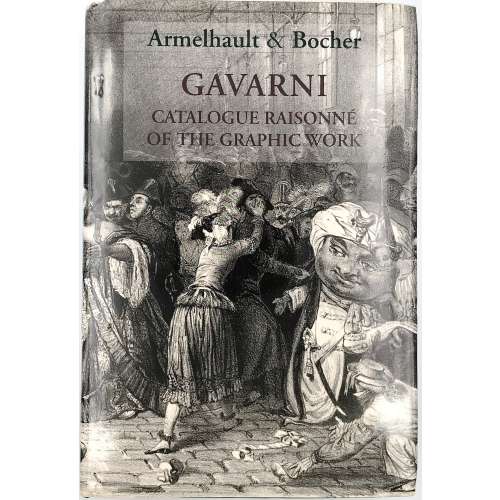
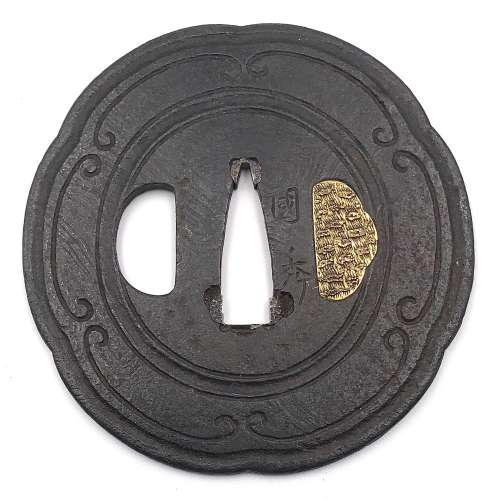
Thin six-lobed iron plate of brownish color is carved on each side with a groove that follows the rim and a concentric grooves around the center of the plate, also carved with six thin scroll lines (mokkō or handles, kan) that follow the shape of the rim. Mokume surface treatment. Hitsu-ana possibly added at a later date, and kogai-hitsu-ana plugged with gold. Silver sekigane.
Signed: Kunihide [國秀]. Higo school, 1st generation swordsmith.
Mid Edo period, ca. 1800.
Would be possibly attributed to Kamakura-bori school revival of the 19th century.
References: Nihon Tō Kōza, Volume VI / Japanese Sword / Kodōgu Part 1, page 231: Enju Kunihide, a tōshō from Higo: "...forging of the jigane is excellent, and there are also pieces with mokume hada."
Haynes Index Vol. 1, p. 741, H 03569.0: "Enju Kunihide in Higo province, died 1830, student of Suishinshi Masahide. Retainer of the Hosokawa Daimyō, etc."
Additional Information from Markus Sesko: This tsuba indeed is made by Enju Kunihide, who in his later years signed the HIDE [秀] character as HI [日] and DE [出], as here: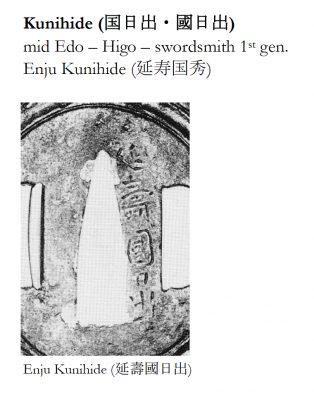 Size: 77.4 x 74.9 x 2.7 mm
Similar pieces are:
1. In this collection № TSU-0341: Kamakura-bori tsuba with mokkō motif. Muromachi period, 15th - 16th century.
2. Dr. Walter A. Compton Collection, 1992, Christie’s auction, Part II, pp. 14-15, №16: “A kamakurabori type tsuba, Muromachi period, circa 1400. The thin, six-lobed iron plate is carved on each side with a wide groove that follows the shape of the rim, and with six scroll lines and a single thin circular groove. […] The hitsu-ana was added at a later date, circa 1500-1550. Height 8.3 cm, width 8.6 cm, thickness 2.5 mm. The tsuba was initially intended to be mounted on a tachi of the battle type in use from Nambokucho to early Muromachi period (1333-1400)”. Sold at $935.
Size: 77.4 x 74.9 x 2.7 mm
Similar pieces are:
1. In this collection № TSU-0341: Kamakura-bori tsuba with mokkō motif. Muromachi period, 15th - 16th century.
2. Dr. Walter A. Compton Collection, 1992, Christie’s auction, Part II, pp. 14-15, №16: “A kamakurabori type tsuba, Muromachi period, circa 1400. The thin, six-lobed iron plate is carved on each side with a wide groove that follows the shape of the rim, and with six scroll lines and a single thin circular groove. […] The hitsu-ana was added at a later date, circa 1500-1550. Height 8.3 cm, width 8.6 cm, thickness 2.5 mm. The tsuba was initially intended to be mounted on a tachi of the battle type in use from Nambokucho to early Muromachi period (1333-1400)”. Sold at $935.
 3. And another one in Robert E. Haynes Catalog #9 on page 24-25 under №23: “Typical later Kamakura-bori style work. This type of plate and carving show the uniform work produced by several schools in the Muromachi </em period. Some had brass inlay and others were just carved as this one is. The hitsu are later. Ca. 1550. Ht. 8.8 cm, Th. 3.25 mm”. Sold for $175.
3. And another one in Robert E. Haynes Catalog #9 on page 24-25 under №23: “Typical later Kamakura-bori style work. This type of plate and carving show the uniform work produced by several schools in the Muromachi </em period. Some had brass inlay and others were just carved as this one is. The hitsu are later. Ca. 1550. Ht. 8.8 cm, Th. 3.25 mm”. Sold for $175.

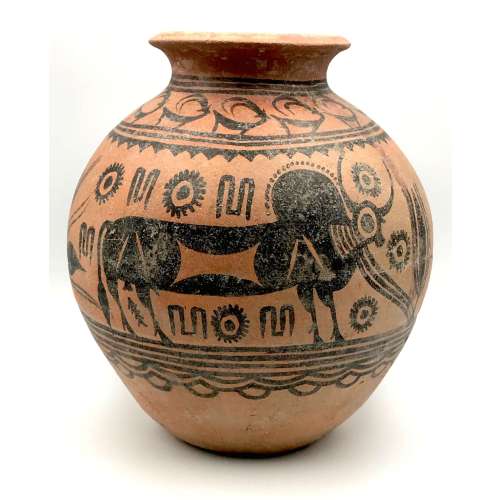
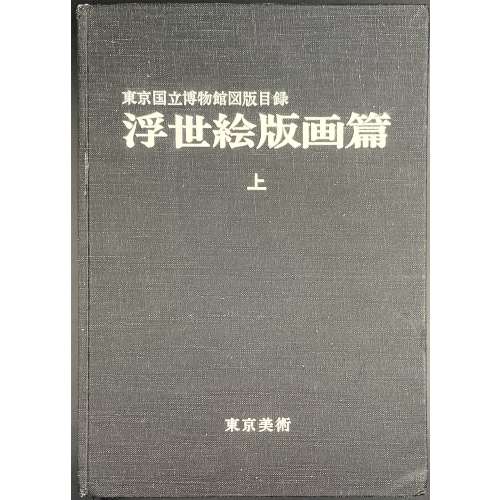
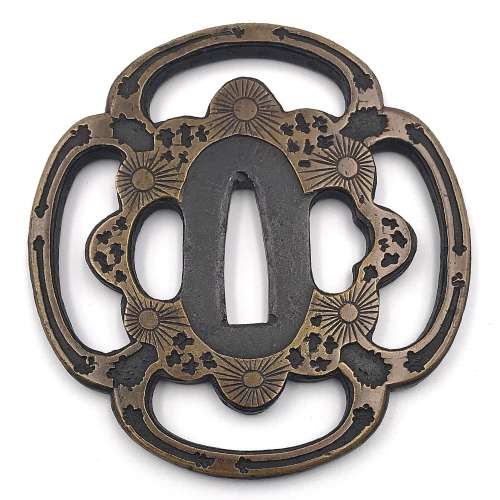
Iron tsuba of mokkō form (mokkōgata) pierced (sukashi) and inlaid with precast dark brass inlay (taka-zōgan) with somewhat abstract/geometrical design that can be liberally described as pines, mist, and snow.
Momoyama or early Edo period. End of the 16th - beginning of the 17th century. Heianjō school. Unsigned. Dimensions: 86.8 x 82.9 x 4.5 mm.